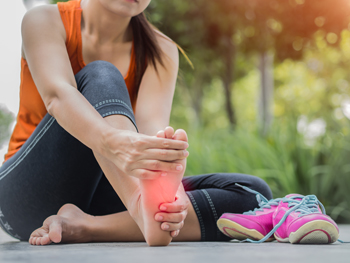Items filtered by date: June 2023
The Do's and Don’ts of Diabetic Foot Care

Diabetes is a condition that can affect the feet. Maintaining proper diabetic foot care is crucial in preventing unwanted foot ailments from developing. This can begin by washing and drying the feet every day, followed by applying a moisturizer on them. It is helpful to refrain from using any creams between the toes, as this may lead to additional foot conditions. Diabetic patients may have neuropathy, which is the inability to feel sensations in the feet and lower legs. As a result, using a mirror is a good way to check the soles of the feet for any cuts or scrapes that may have developed. It is beneficial to have the toenails properly trimmed weekly, and this helps to prevent an ingrown toenail from developing. Many people who are diabetic know the importance of refraining from walking barefoot, which can be detrimental to the feet. If you have diabetes, it is strongly suggested that you are under the care of a podiatrist who can help you to manage this serious condition.
Diabetic foot care is important in preventing foot ailments such as ulcers. If you are suffering from diabetes or have any other concerns about your feet, contact James P. Huish, DPM from Arizona. Our doctor can provide the care you need to keep you pain-free and on your feet.
Diabetic Foot Care
Diabetes affects millions of people every year. The condition can damage blood vessels in many parts of the body, especially the feet. Because of this, taking care of your feet is essential if you have diabetes, and having a podiatrist help monitor your foot health is highly recommended.
The Importance of Caring for Your Feet
- Routinely inspect your feet for bruises or sores.
- Wear socks that fit your feet comfortably.
- Wear comfortable shoes that provide adequate support.
Patients with diabetes should have their doctor monitor their blood levels, as blood sugar levels play such a huge role in diabetic care. Monitoring these levels on a regular basis is highly advised.
It is always best to inform your healthcare professional of any concerns you may have regarding your feet, especially for diabetic patients. Early treatment and routine foot examinations are keys to maintaining proper health, especially because severe complications can arise if proper treatment is not applied.
If you have any questions please feel free to contact our office located in Safford, AZ . We offer the newest diagnostic and treatment technologies for all your foot and ankle needs.
Ways to Lower the Risk of Running Injuries

One of the main causes of running injuries is simply overdoing it. Experts believe that at least 70 percent of runners develop overuse injuries at some point each year. Typically, such an injury is the result of running too far, too fast, or too soon after a previous injury. Luckily, there are ways to reduce the likelihood of this outcome. First, if you are a beginning runner, it is wise to start slow and alternate running and walking. Running experts recommend increasing mileage by no more than 10 percent per week. Furthermore, it is thought that running more than 45 miles in a week can put a runner at greater risk of an overuse injury. Replacing running shoes every 500 miles is acknowledged as a best practice among runners. Additionally, it is helpful to avoid uneven and slanted running surfaces, or running through pain. In fact, if you experience pain, it is thought wise to rest for a few days. If the pain returns when you run again, it is suggested that you make an appointment with a podiatrist who can take a history of your running habits, examine your feet, and determine the source of the pain. Treatment options will also be explored.
Exercising your feet regularly with the proper foot wear is a great way to prevent injuries. If you have any concerns about your feet, contact James P. Huish, DPM of Arizona. Our doctor will treat your foot and ankle needs.
How to Prevent Running Injuries
Many common running injuries are caused by overuse and overtraining. When the back of the kneecap starts wearing out and starts causing pain in your knee, this is commonly referred to as runner’s knee. Runner’s knee is a decrease in strength in your quadriceps and can occur if you’re not wearing properly fitted or supporting shoes. To prevent runner’s knee, focusing on hip strengthening is a good idea, as well as strengthening your quads to keep the kneecaps aligned.
What Are Some Causes of Running Injuries?
- One cause of a common running injury is called iliotibial band syndrome.
- Plantar fasciitis is also another common injury.
- Stress fractures can occur from overtraining, lack of calcium, or even your running style.
Best Ways to Prevent Running Injuries
- Wear footwear that fits properly and suits your running needs.
- Running shoes are the only protective gear that runners have to safeguard them from injury.
- Make a training schedule. Adding strengthening exercises as well as regular stretching can help keep you strong and limber and can lessen the possibility of injuries.
- Stretching keeps muscles limber; this will help you gain better flexibility.
If you have any questions please feel free to contact our office located in Safford, AZ . We offer the newest diagnostic and treatment technologies for all your foot and ankle needs.
Foot Wounds and Diabetes

Complications from foot wounds can be serious in patients who have diabetes. When blood sugar levels are too high, the blood vessels can narrow and arteries can stiffen. This blocks blood flow, oxygen, and important nutrients needed to help heal wounds. Wounds can become infected and the compromised immune system in diabetics may not be able to fight it. This type of infection can spread to soft tissue, bone, and blood, which could lead to sepsis. Neuropathy is common among diabetics which is a condition that damages the nerves in the legs and feet. Neuropathy may lead to a loss of sensation, making it difficult to feel foot problems arising. Neuropathy can also make it difficult to walk and increased pressure can be put on certain parts of the feet to help diabetics sense the floor. This pressure can cause skin to break down and ulcers to form. Closely monitoring blood sugar levels and wearing protective and well-fitting shoes may help diabetic patients in preventing abrasions from developing on their feet. If you have diabetes, it is strongly suggested that you include a podiatrist on your healthcare team. This medical professional can routinely examine your feet and help you keep on top of any issues that might emerge.
Wound care is an important part in dealing with diabetes. If you have diabetes and a foot wound or would like more information about wound care for diabetics, consult with James P. Huish, DPM from Arizona. Our doctor will assess your condition and provide you with quality foot and ankle treatment.
What Is Wound Care?
Wound care is the practice of taking proper care of a wound. This can range from the smallest to the largest of wounds. While everyone can benefit from proper wound care, it is much more important for diabetics. Diabetics often suffer from poor blood circulation which causes wounds to heal much slower than they would in a non-diabetic.
What Is the Importance of Wound Care?
While it may not seem apparent with small ulcers on the foot, for diabetics, any size ulcer can become infected. Diabetics often also suffer from neuropathy, or nerve loss. This means they might not even feel when they have an ulcer on their foot. If the wound becomes severely infected, amputation may be necessary. Therefore, it is of the upmost importance to properly care for any and all foot wounds.
How to Care for Wounds
The best way to care for foot wounds is to prevent them. For diabetics, this means daily inspections of the feet for any signs of abnormalities or ulcers. It is also recommended to see a podiatrist several times a year for a foot inspection. If you do have an ulcer, run the wound under water to clear dirt from the wound; then apply antibiotic ointment to the wound and cover with a bandage. Bandages should be changed daily and keeping pressure off the wound is smart. It is advised to see a podiatrist, who can keep an eye on it.
If you have any questions, please feel free to contact our office located in Safford, AZ . We offer the newest diagnostic and treatment technologies for all your foot care needs.
Toe Walking in Children

Children’s health is a significant concern for parents, as it should be. The health of children’s feet is no exception. Children under age two commonly walk on the balls of their feet instead of with their heels touching the ground. This is known as toe walking. Most children will graduate from this gait pattern and walk heel-to-toe. If a child continues to walk this way, they might develop tight calf muscles, and walking in a typical way will become harder to learn. There is no known reason why a child may prefer to walk on their toes past young toddler age. However, if a youngster has certain conditions, such as cerebral palsy, muscular dystrophy, a spinal cord abnormality, or autism, this way of walking is more likely. To rule out any reasons for concern if your child toe walks, it is suggested that you consult with a podiatrist who can do an examination and discuss anything of significance.
The health of a child’s feet is vital to their overall well-being. If you have any questions regarding foot health, contact James P. Huish, DPM of Arizona. Our doctor can provide the care you need to keep you pain-free and on your feet.
Tips for Keeping Children's Feet Healthy
- Make sure their shoes fit properly
- Look for any signs of in-toeing or out-toeing
- Check to see if they have Clubfoot (condition that affects your child’s foot and ankle, twisting the heel and toes inward) which is one of the most common nonmajor birth defects.
- Lightly cover your baby’s feet (Tight covers may keep your baby from moving their feet freely, and could prevent normal development)
- Allow your toddler to go shoeless (Shoes can be restricting for a young child’s foot)
- Cut toenails straight across to avoid ingrown toenails
- Keep your child’s foot clean and dry
- Cover cuts and scrapes. Wash any scratches with soap and water and cover them with a bandage until they’ve healed.
If you have any questions, please feel free to contact our office located in Safford, AZ . We offer the newest diagnostic and treatment technologies for all your foot care needs.

